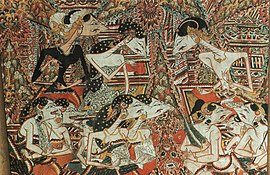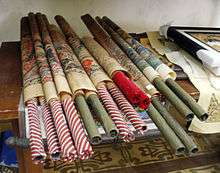Wayang beber
Wayang beber is a wayang performance art whose presentation is manifested in a stretch of paper sheets or illustrated fabric with stylized wayang kulit accompanied by a narrative by a puppeteer. The word beber comes from the word njlentrehake or ambeber, which means stretching. The wayang beber performances appeared and developed in Java in pre-Islamic times, but continued into the Islamic empires (like the Mataram Sultanate). The story shown is taken from both Mahabharata and Ramayana. After Islam became the main religion in Java, more Panji stories were displayed. Wayang Beber is one of the oldest types of wayang in Indonesia.[1][2]

The first foreign record of this performance was reported by Ma Huan and Fei Xin in the book Ying-Yai-Sheng-Lan. The book tells of Zheng He visit to Java around 1413-1415 (the Majapahit kingdom was led by Wikramawardhana, son of Hayam Wuruk). They watched as people crowded around listening to someone tell stories about the images displayed on partially rolled up sheets of paper. The narrator holds a piece of wood that is used to point to the pictures contained on the sheet. Such practices are still the same as later puppet shows. However, according to narration from Javanese poets, wayang beber begins with the Kingdom of Pajajaran in West Java.
Pictures of puppet scenes are depicted on sheets of cloth or deluwang, each sheet containing several scenes (called pragers) in accordance with the order of the story. These images are played in a "unfolded" manner, ie unrolling according to the scene one by one. Puppeteer tells about things related to the scene being displayed, including dialogue.
It is said that by Walisanga, among them is Sunan Kalijaga, this wayang beber was modified to form a shadow puppet with a form of ornamental form that is known today, because Islamic teachings do not advocate the form of images of living creatures (humans, animals) or statues. This modified puppet guardian is used to spread the teachings of Islam and what we know today.
History

Wayang beber began to exist and developed in the era of the Kingdom of Jangggala in 1223 AD At that time, the shape was still not perfect, because the pictures were made on siwalan or rontal or palm leaves.
In 1244 AD the wayang beber began using paper. This rather yellowish colored paper is called "dlancang gedog". The resulting image is still black and white. Whereas in the year 1316 AD, at each end of the paper puppet roll, given / installed a long wooden stick that serves to roll the story or show the next story.
During the reign of King Brawijaya V (circa 1378 AD), the king ordered his 7th son, Raden Sungging Prabangkara to learn puppets and also to create a new Wayang Beber Purwa puppet, which is a picture of puppet play on paper began to use several colors.[3]
Performance

The wayang beber performances can be performed day or night, except Friday night Kliwon because on that night, the wayang beber must be given offerings. Meanwhile, during the fasting month or Ramadan it is not permitted to perform wayang beber shows.
Meanwhile, for puppeteer wayang beber must be a man and his masterminding skills passed down through the generations orally to the next generation, who is usually a son of the Dalang himself. If the puppeteer does not have a son, the masterminding skill can be passed on to one of his nephews who is also male.
See also
References
- "Kisah Wayang Beber Wayang Tertua Di Indonesia". Indonesia.go.id (in Indonesian). 2019-04-08. Retrieved 2020-07-02.
- "Wayang Beber, Wayang di Indonesia". Metrum.co.id (in Indonesian). 2014-05-08. Retrieved 2020-07-02.
- "Sejarah Wayang Beber". viva.co.id (in Indonesian). 2019-06-25. Retrieved 2020-07-02.